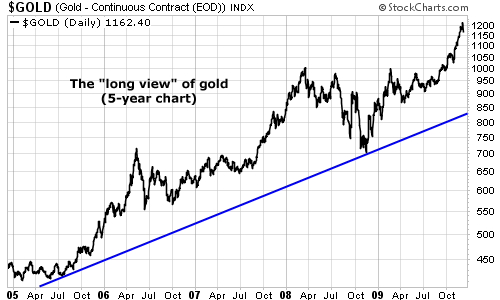| Home | About Us | Resources | Archive | Free Reports | Market Window |
Warning: The Stock Market Is Extremely Overvalued Right NowBy
Tuesday, December 8, 2009
Andrew Smithers is a world expert in stock market valuation...
Smithers is an "econometrician." He studies stock market statistics going back more than 100 years and creates indicators from these statistics to judge whether the stock market is cheap or expensive. His two favorite valuation indicators are named the "CAPE" and the "q." CAPE stands for Cyclically Adjusted Price Earnings. You've heard of the price-to-earnings ratio. CAPE is like the P/E ratio, except it smoothes earnings over 10 years to take out the impact of booms and busts. CAPE data go back 127 years. The q is a ratio of stock prices to asset values. You've heard of the price-to-book ratio. Book value is a company's "net worth" after you add up all the assets and subtract all the liabilities. The q is like the price-to-book ratio, except instead of book value, it uses the replacement cost of assets. Replacement cost is closer to reality than book value, as it reflects price inflation. Data for q go back to 1900. In March 2000, Smithers and another economist, Stephen Wright, published a bestselling book titled Valuing Wall Street. In this book, they explained these indicators and used them to show the stock market was as much as 2.5 times overvalued at the end of 1998. "The end of the twentieth century was almost certainly the very best time in the entire century to sell stocks," they concluded. The Nasdaq bubble collapsed the month their book arrived in bookstores. Before the recent credit crunch, Smithers was sounding the alarm again... In a January 2008 article, Smithers wrote, "Stock markets are vulnerable because they are overpriced... Investors should be aware that the downside potential for asset values looks far greater than the upside." Right now, Smithers' indicators show the stock market is more than 40% overvalued. (At the most recent data point – September 17, 2009, when the S&P was at 1,069 – q showed the market was 41% overvalued and CAPE showed the market was 37% overvalued.) At 40% overvalued, the market is the most overvalued it's ever been except for the peaks in 1929, 2000, and 2007. "The S&P 500 is priced to deliver one of the weakest 10-year total returns in history except for the (ultimately disappointing) period since the mid-1990s," says Smithers. To see a chart of the q and CAPE going back 100 years, click here. Here's the thing that scares me: Smithers' ratios move like yo-yos around an average. Economists would call them "mean-reverting," meaning they bounce from overvalued to undervalued. In 2000, both indicators hit extreme highs. Both were almost double the previous record stock-market overvaluation, recorded in 1929. This leads me to think we'll see extreme levels of undervaluation in these indicators at some point in the future. If these indicators reach the same levels of undervaluation they hit at the market bottoms in 1921, 1932, 1949, or 1982, the S&P would need to fall to around 400... In sum, you should be careful with the stock market right now. It's extremely overvalued from a historical perspective and there's the potential for a major decline in stock valuations over the next decade. On the other hand, keep an eye on Smithers' chart. When the q and the CAPE fall below –0.4, this will be the moment to begin investing heavily in stocks again. Good investing, Tom P.S. You should buy Smithers' book. It's one of the all-time great stock market books. I take it off my shelf at least four times a year. It's an easy read, written for the individual investor. You can find it on Amazon here. Or check out Smithers' website here. Market NotesHOW TO VIEW THE FALLING GOLD PRICE
It's amazing what a $50-per-ounce drop in the price of gold does nowadays.
The decline is front and center in the financial papers. CNBC hosts are grilling every analyst they can find with drivel like, "What a drop! Is the gold rally now dead?" Our advice to the nervous gold owner: Sit back and take the "long view" of gold. Remember, no bull market rises in a straight line to the sky. And gold regularly experiences wild swings in price. Gold is the "odd man out" among financial assets. It's not like a rental property, where you can say, "I'll pay eight times annual rent for this." Or a blue-chip stock, where you can say, "I'll pay 10 times annual cash flow for this." Gold represents real wealth and crisis protection. Folks go through periods where they'll dump this protection... or buy it with both hands. This leads to lots of volatility, like we've seen in the past few days. It could even lead to a bigger drop in gold. But as you can see from today's five-year chart of gold, the yellow metal could drop all the way down to $850 an ounce and still remain in the confines of a big bull market. This sort of drop is unlikely, but anything can happen in the gold market... so be prepared. 
|
In The Daily Crux
Recent Articles
|

